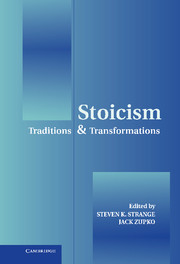Book contents
- Frontmatter
- Contents
- List of Contributors
- Acknowledgments
- List of Abbreviations
- Stoicism
- Introduction
- 1 The Socratic Imprint on Epictetus' Philosophy
- 2 The Stoics on the Voluntariness of the Passions
- 3 Stoicism in the Apostle Paul: A Philosophical Reading
- 4 Moral Judgment in Seneca
- 5 Stoic First Movements in Christianity
- 6 Where Were the Stoics in the Late Middle Ages?
- 7 Abelard's Stoicism and Its Consequences
- 8 Constancy and Coherence
- 9 On the Happy Life: Descartes vis-à-vis Seneca
- 10 Psychotherapy and Moral Perfection: Spinoza and the Stoics on the Prospect of Happiness
- 11 Duties of Justice, Duties of Material Aid: Cicero's Problematic Legacy
- 12 Stoic Emotion
- Works Cited
- Name Index
- Subject Index
8 - Constancy and Coherence
Published online by Cambridge University Press: 11 July 2009
- Frontmatter
- Contents
- List of Contributors
- Acknowledgments
- List of Abbreviations
- Stoicism
- Introduction
- 1 The Socratic Imprint on Epictetus' Philosophy
- 2 The Stoics on the Voluntariness of the Passions
- 3 Stoicism in the Apostle Paul: A Philosophical Reading
- 4 Moral Judgment in Seneca
- 5 Stoic First Movements in Christianity
- 6 Where Were the Stoics in the Late Middle Ages?
- 7 Abelard's Stoicism and Its Consequences
- 8 Constancy and Coherence
- 9 On the Happy Life: Descartes vis-à-vis Seneca
- 10 Psychotherapy and Moral Perfection: Spinoza and the Stoics on the Prospect of Happiness
- 11 Duties of Justice, Duties of Material Aid: Cicero's Problematic Legacy
- 12 Stoic Emotion
- Works Cited
- Name Index
- Subject Index
Summary
In the French language, to call someone a Stoic is to recognize the virtue of standing firm in adversity, of enduring misfortune with courage and tenacity, without being driven from the path one has chosen. The characteristic Stoic attitude thus appears to be constancy. The image of the sage as a rock, immovable in a storm, was a standard trope in French moral literature during the seventeenth century. On the mark of the publisher Plantin we read the motto, labore et constantia (by labor and constancy). This illustrates the extent to which this virtue seems characteristic of the rebirth of the Stoic movement at the end of the Renaissance. The restoration began with the philological work of the humanists, but it is also tied to a definite political context, marked by the renewed outbreak of religious troubles and civil war. Treatises on the subject of constancy flourished at the end of the sixteenth and beginning of the seventeenth centuries and had impressive publishing histories. But treating constancy as a cardinal virtue was not merely a compromise choice: Charron had preferred prudence, Descartes generosity, Pascal charity. Constancy is the virtue of someone who relies first and foremost on his own strengths and not on God or others. As Lipsius says, a man writes a treatise on constancy primarily for himself and his own benefit, and not because he seeks fame.
- Type
- Chapter
- Information
- StoicismTraditions and Transformations, pp. 148 - 176Publisher: Cambridge University PressPrint publication year: 2004
- 2
- Cited by



